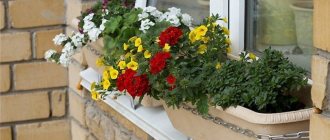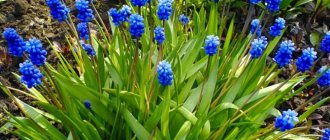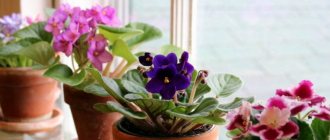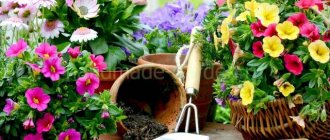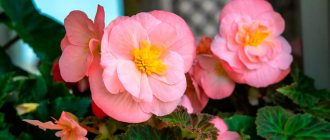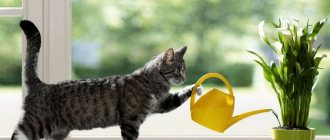2018 broke the scale of fashion interior values. Now - suddenly! – it is announced that a house without greenery is a thing of the past, that it is old and inexpressive. Suddenly it turned out that interior design without plants looks unfinished and faceless.
It lacks the fireworks of colors, grooming, originality, it looks bare and uninhabited. Everything can be learned by comparison: indeed, several living green plants in the interior of an apartment so transform the appearance of the room that if you remove them, a vacuum will form that cannot be filled even with very beautiful things.
Indoor plants transform the interior
This news inspired some to go to flower shops, others plunged into panic - after all, there are people in whose hands even a cactus will wither. Let us reassure you right away: there are acceptable design options for everyone; as a last resort, you can buy artificial plants for the interior.
But where to start? Certainly not from buying flowers!
Until then you will have to:
- find out whether vegetation in the house is useful;
- determine which corners of the apartment lack green areas and what role they can play in zoning and visual transformation of space;
Indoor plants can participate in room zoning
- figure out whether it is possible to combine the beautiful with the useful - with the edible, for example;
- decide in what frame the living accessories will appear - get acquainted with the types of pots, cache-pots, shelves, jardinieres, florariums;
- recover from the shock of discovering what unusual interior landscaping options designers have come up with (oh, believe me, they have nothing to do with geraniums on the window);
Consider unusual landscaping options
- breathe a sigh of relief upon learning about the existence of closed automated life support systems for plants in the interior;
- grab your heart (or wallet) by finding out how much such systems cost;
- assess the degree of illumination, humidity, temperature;
- develop a project for placing plants in the interior of the house;
- and only after that, choose the plants themselves for the interior - with the help of a designer or flower seller, taking into account the architectural style and your own inclination (or not inclination) towards floriculture.
Indoor plants should be in harmony with the interior style
It is reassuring that there is a grain of humor in such a serious algorithm. In the end, even randomly found flowers, geranium or ficus, will add the forgotten sweetness of good old traditions to the design and will be regarded by aesthetes as a fashionable touch. But we want more?
So, put aside your fears and go ahead and explore the green world of modern design!
Myths about houseplants
Superstitions regarding indoor flowers that ward off good luck are controversial, but arguing with them is a thankless task. Whether this is true or not, ivy has a bad reputation as a persecutor of men. It is believed that ivy prevents a lonely young lady from bringing a man into the house, and even more so from keeping him. At the same time, in narrow circles of magicians and fortune tellers, they note the ability of ivy to extinguish emissions of energy - both good and bad. Conclusion: after a scandalous breakup with a lover, ivy is just the pill that will help you forget, forgive and calm down.
There is talk about ivy's ability to dampen energy releases - both good and bad.
By the way, after ivy, its specific properties began to be attributed to other climbing plants in a residential building. It’s somehow a pity to abandon such a decorative category of indoor flowers because of unsubstantiated accusations, especially since ivy is clearly in trend.
The orchid suffers for almost no reason - it has been attributed to a suffocating effect due to the mere appearance of the roots, which supposedly entangle the sleeping person.
All the discussions about plants releasing carbon dioxide at night are pure truth. However, in the bedroom their presence is critical only if the room is hermetically sealed and not ventilated. To be honest, in such conditions it will be stuffy even without flowers.
Ventilate rooms with flowers
A more serious version seems to be that strong-smelling flowers interfere with night rest. Indeed, the intoxicating aroma can give you a headache during the day, although all this is very individual.
For allergy sufferers, any contact with pollen is undesirable; it is better for them to choose indoor flowers with decorative leaves. However, the soil also poses a danger, spreading fungal spores. This does not mean that you will have to give up your home greenhouse: you can, for example, cultivate green lawns using a hydroponic artificial irrigation system or use artificial flowers that skillfully imitate natural ones.
Plants in a hydroponic system are suitable for allergy sufferers
Conditionally poisonous plants pose a real serious threat and should be used with great caution. Poisonous greens include: aglaonema, anthurium, alocasia, croton, monstera, spurge, oleander, pachypodium, fatsia, dieffenbachia - their photos must be carefully studied and remembered.
Surprisingly, almost all of them turned out to be designers' favorites in 2018 - these plants are so picturesque! Shouldn't we give up such beauty? As a last resort, they can be placed in the upper tier of landscaping - it’s safer.
Picturesque monstera in the interior
It remains to add that, with very rare exceptions, plants in the interior of a residential building play the role of an island of nature, which refreshes and moisturizes the air, soothes, and pleases the eye.
Application options in interior design
The comfort of living in a house or apartment largely depends on how well the plants are selected. This concerns not only and not so much the design as the functional purpose of the room. Thoughtlessly filling rooms with exotic flora will not bring anything good either to the apartment owners or to the plants themselves. When purchasing flowers, you need to realistically assess your capabilities and be strictly aware that you will be able to care for them.
Living room
The living room is the largest, most elegant room for receiving guests. Large and broad-leaved outdoor plants are appropriate here. In a small room there is room for climbing plants and compact specimens in hanging flowerpots and baskets. Next to traditional indoor crops, freshly cut flowers in vases look beautiful and unusual. To maintain the lightness and elegance of the interior, designers recommend using transparent glass flasks or aquariums.
Kitchen
The kitchen is one of the most favorable places for a home botanical garden. This room is well lit and has a higher humidity level than other rooms. Considering that food is prepared here, the air temperature in the kitchen is higher than in the living rooms. Therefore, this is the place for light- and heat-loving crops. However, green pets should not be placed near the stove, as they can get sick or die from excessive heat. The area near the sink is also not the best place, as soap splashes and drops of grease can damage the flowers. It is necessary to correlate the size of the plants and the kitchen space. The kitchen microclimate is best tolerated by ivy, chlorophytum, tradescantia, asparagus and aloe. In addition, chlorophytum purifies kitchen air from harmful fumes.
A great idea for the kitchen is a miniature “vegetable garden” with green onions, parsley, basil, mint and decorative peppers. An interesting design solution is the use of kitchen utensils instead of the usual flowerpots.
Bedroom
The task of flowers in the bedroom interior is to fill it with tenderness, peace and comfort. Another important rule: there should not be many plants in the bedroom. This is especially true for strong-smelling flowers. A pungent or suffocating aroma can cause sleep disturbances and headaches. There is no place for ferns and lilies in the bedroom, as they absorb oxygen and release carbon dioxide in return. Plants can be placed on the floor (if space allows), on tables, bedside tables or window sills. It all depends on how light-loving they are. Aloe and Kalanchoe are great for the bedroom, as they release oxygen at night and create a favorable microclimate. An interesting idea is a combination of living plants and photo wallpaper with a “plant” picture on an accent wall.
Children's
The principles for choosing colors for a nursery are simple: they should be pleasing to the eye, be safe and have a beneficial psycho-emotional effect on the child. The best plants for a nursery are:
- Crassula "money tree". This plant programs for positivity.
- Cyclamen. It has been found to promote creativity.
- Usambara violet, soleirolia. These decorative flowers have the unique ability to improve your mood. Girls especially like violets.
Just like in the bedroom, you don’t need a lot of flowerpots in the nursery. A couple of small pots will be enough.
Hallway
The hallway is the first room where visitors enter when entering a house or apartment. Is there room for plants in the hallway? Of course there is. If there is a window, this is, of course, good luck, but if there is not enough light, you can think about purchasing shade-loving plants. These are marranta, sanseviera, dracaena or fatsia. They are unpretentious, tolerate lack of lighting and temperature changes inherent in the hallway.
When choosing plants for the hallway, you need to pay attention to the square footage of the room. If it is spacious enough, large, lush views will look good. For example, a fern would be appropriate both in a group with other crops and as a stand-alone accent. For a small area, small flowers placed on special shelves and stands are desirable. An example is Heder's ivy. This small but very beautiful plant will transform the hallway and create an atmosphere of indescribable comfort and coziness.
Bathroom
The bathroom is a closed space, so the correct selection of plants is very important. The benefits of homemade flowers in the bathroom are as follows:
- Plants release oxygen, have a disinfecting effect, and create a favorable and comfortable microclimate.
- Destroy unpleasant odors.
- They improve your mood with a beautiful view.
The bathroom is a hot and humid place, so it makes sense that tropical species would do best here. These are yucca palms, dracaenas, orchids, bamboo, spathiphyllum, croton, and various types of ferns. It is especially easy to choose a flower if the bathroom has a window. However, in any case, plants placed in the bathroom require special care:
- The room needs to be ventilated regularly.
- Watering flowers is moderate, as the soil dries out. Stagnant water will harm even the most moisture-loving plants.
- In winter, there is no need to feed flowers.
- If there is no window in the bathroom, it is necessary to install fluorescent lamps. Special phytolamps designed for greenhouses are also perfect. They are not cheap, but they are completely worth it.
- Periodic movements from the bathroom to the balcony or kitchen will also benefit the plants.
Depending on the size of the room, plants can be placed on the floor, walls, special stands or window sills. Putting flowers on a washing machine or placing them near heating appliances is prohibited.
The triumphant return of the ficus - new botany in the interior
How did it happen that in 2022, designers turned to indoor plants? This became a logical continuation of the idea of ecological phytodesign of the interior, which the Japanese and Scandinavians have never changed. The need for natural materials, natural forms and islands of nature inevitably resulted in an interest in house plants and the search for their new role in home decoration.
The revolutionary direction was called “new botany”. It has penetrated into the interior of all existing styles, from urban to country, from minimalism to classic.
The mission of indoor plants is to harmonize the design of the home and bring a new melody to it.
Indoor plants will bring a fresh note to the interior
How necessary are indoor plants in the interior of an apartment decorated in a certain style, and which ones should you give preference to?
Bright visual accent
Exotic flowering plants, including orchids, tuberoses, Amazon lilies and other flowers, attract the eye and emphasize the individuality of the home.
Fashionable aesthetics of the concrete jungle - a combination of loft and living plants
What does ficus do in a loft interior? No, he's not blocking a hole in the wall!
A large plant in an urban interior plays the same role as a red leather sofa or a painting in a gilded frame - working “in contrast”, it emphasizes the picturesque imperfections of industrial textures.
Well-groomed greenery against a background of concrete or brickwork enhances the shocking effect. For loft apartments, voluminous plants with expressive large leaves are selected, in stone tubs or metal containers adapted for them (photo).
Plants with large leaves are suitable for loft apartments
A daring technique for landscaping a loft is an imitation of an industrial greenhouse. Industrial lattice glazing, irrigation pipes and lush greenery in an enclosed space develop style ideas in an unexpected way.
Plants in flasks, transparent balls, in glass jars - these fashionable florariums seem to be created to create local green accents in an urban interior.
Florariums are ideal for loft-style interiors
Warm to cold: indoor flowers in a high-tech interior
What might greenhouses look like on a space station? Probably the same as plants in high-tech apartment design projects.
First of all, these are lawns, horizontal and vertical. By the way, a vertical lawn is a complex engineering structure with an automatic watering system, which conceptually fully complies with the principles of high-tech style.
Vertical gardening for high-tech interiors
Florariums, miniature and voluminous, are semi-closed ecosystems with a microclimate. They are picturesque and perfectly harmonize with the glossy surfaces of the interior.
A vintage element – ceiling plants growing “upside down”. This is something that surprises immensely every day, something that is impossible to get used to. But it is in high-tech that such interior landscaping seems quite logical.
Creative plants growing upside down
Heroes of eco-design – all areas of country style
What did the fashion trend of “new botany” give to the country style, in which flowers and green plants were traditionally present? First of all, he raised the status of the country music genre. Secondly, the developments of the new wave gave interior designers fresh ideas and magnificent floral accessories - stands, whatnots, jardinieres, flowerpots.
It would be a slight exaggeration to say: there are so many country style trends. Let's consider techniques for using indoor flowers and plants in the interior of city apartments with rural design.
Flowers and scents of Provence
In the French provincial style of Provence, flowering crops are in the lead:
- roses;
- violets;
- geranium;
- oleander;
- bulbous - tulips, hyacinths, daffodils, crocuses;
- mini-lawns in pots made of cereals, lavender, herbs.
- as well as evergreen laurel, ficus, etc.
Violets will fit perfectly into a romantic interior in Provence style
The peculiarity of Provence is the adaptation of a variety of containers as flower pots and ingenuity in their handicraft decoration. They are painted, aged, covered with craquelure and patina.
An important element is the abundance of shelves, jardinieres, shelves and improvised pedestals for plants. In Provence, it is customary to place flower pots on the windowsill, on the kitchen sink or dining table.
In Provence, it is customary to place flower pots on the windowsill
American country
The least affected by new landscaping ideas is American country music; this style is incredibly conservative. A few wooden or ceramic plant pots are more than enough to liven up your farmhouse interior.
Several plants in ceramic pots will decorate a country-style interior
Japanese mini gardens
In the tradition of Japanese interior - admiring plants, stones, wood. All three elements are present in living plant compositions in the Japanese style.
Bonsai for a laconic interior in Japanese style
Plants in Japanese interiors are never presented without a frame. A wooden stand, a clay or wooden pot, stones and sand covering the ground, a lone bonsai tree or a plant composition - all this makes up a single whole.
Mediterranean style: blooming shore
A sunny Mediterranean interior with elements of rough antiquity is filled with special charm when southern flowers and plants settle in it - indoor cypresses, papyrus, oleander, ivy, roses, etc.
Indoor cypress trees
Ceramics, stone, mosaics, wood, metal, fabrics and ropes are used in the design of pots.
The degree of illumination is an important factor in choosing vegetation
The style of the room influences the choice of green spaces, but it is equally important to consider the degree of illumination of the room, the interior of which is planned to be decorated with flowers.
Comment! In order for plants to reveal their beauty to the fullest, it is important to create optimal conditions for their growth and provide proper care.
It is recommended to decorate the interior of a room facing north, where there is a problem of insufficient natural light, with shade-loving indoor plants. These include:
- ferns;
- dracaena;
- spathiphyllum (pictured);
- monstera deliciosa;
- cyclamens;
- Dieffenbachia (pictured);
- aspidistra;
- ficus;
- anthurium, the photo of which amazes with its unusual beauty.
A well-lit interior of a room with windows facing south can be decorated with:
- haworthia;
- aloe;
- camellia japonica;
- sambac;
- prickly pear.
A space facing east is decorated with the following indoor plants:
- geranium;
- oleander;
- myrtle;
- violets;
- small-leaved ficus;
- fuchsia;
- dracaena;
- azalea.
The eastern side creates the most optimal atmosphere for growing indoor plants.
The following examples will decorate the interior of a room facing west:
- Sansevieria;
- date palm;
- begonia;
- asparagus;
- gasteria;
- eucalyptus;
- jasmine.
The following photos will help you enjoy the beauty of the interior with numerous plants:
Scandinavian clean lines
In the Scandinavian interior, indoor plants carry the same load as large designer accessories: they give minimalism the charm of elitism. Each plant is “presented” so that it is the center of attention.
What new things have the trendsetters in the field of design enriched this style with? Lawns came into the interior. They have been used before in the Scandinavian style, but only selectively. Now the lawn is given a wall, a podium, and some other significant spaces. In continuous landscaping, cereals, moss, hanging plants and low leafy plants are used.
Interior landscaping in Scandinavian style
It was in the Scandinavian style that vertical hanging gardens were first used. They are framed like a painting. They create a picturesque carpet of stems and leaves of different textures. Built into niches. They replace the walls.
Vertical flower bed in a Scandinavian interior
Florariums – inventive mini-greenhouses for dwarf plants – effectively and organically complement the decor.
An extravagant way to present plants is hanging flowers from the ceiling. And a completely surreal example of phyto-interior design - inverted pots with stems growing downwards.
Classics and phytointerior design: the embodiment of decency
The classic interior and its lightweight version - neoclassicism - have never particularly needed support from plant decor. Now the current classic design involves creating a green island in the room from several plants on jardinieres, shelves or in floor planters.
Green islands in a classic interior
The hallway can greet guests with a luxurious palm tree in tubs, and in the living room, behind the back of the sofa, an unusual carpet will unfold - a vertical panel of flowering and deciduous plants. The new face of a classic interior is defined by vibrant green accents.
Flower terrariums
A novelty in the new trends are statements by professional designers about the possibility of equipping a home terrarium for flower arrangements. Fresh originality allows you to design your interior in a new way.
- One flower is wonderful, but in its beauty and popularity it will be difficult to compare with a small compositional range of different plants.
- By allocating any corner of the room for its habitat, you can gain confidence in advance in such a surprisingly original solution.
You won't be able to grow plants quickly. This is the reason why you will have enough time to create and truly enjoy watching flowers grow.
Always, if desired, having your own imagination, you can create settlements of the plant kingdom.
Maximalism in everything or the Revival of true luxury
The modern interior of apartments, “brought up” on ascetic minimalism, misses luxury. This is noticeable in many trends - the return of velvet, damask ornament and lacquer polishing of expensive furniture, in the rich terracotta palette that replaced Marsala, in relation to indoor plants, which have moved from occasional decor into the category of a powerful, conceptual architectural form.
Green oasis of indoor plants
Green areas in the apartment are designed comprehensively. Their role in zoning is thought through, lighting and humidity are checked for compliance, and maintenance is planned. They have become larger, more creative, more diverse.
Vertical green area in the apartment
At the same time, a good modern interior is characterized by some irony and a lack of narcissism. Example? Yes, here it is, in front of you - a little mischief in the kitchen, and not only.
I raised you - I will eat you: about beautiful and tasty phytodesign
It turns out that nothing human is alien to high fashion. She blessed - there is no other way to say it - the creation of garden greenhouses, the placement of edible indoor plants in the interior of a city house. Moreover, for many, this activity has become an incredibly contagious hobby, and amateur designers are in the process of searching for new “tricks.”
First of all, let's look at the kitchen and dining room. All kinds of bucket jars, as well as quite respectable flowerpots (depending on the style of the interior) are densely planted with parsley, watercress, arugula, mustard, basil and other spicy herbs. Nobody strives to bring it to a state of biological ripeness. When it grew, they cut it down and planted a new one.
Spicy herbs are appropriate in the kitchen interior
If opportunities allow, you can decorate a phytopan above the dining area.
Another option for selecting plants is “guests from the dacha.” At the end of the summer season, bushes of dwarf tomatoes and peppers move into the kitchen (chili looks especially nice). Of course, they can be grown directly in pots, bypassing the garden beds.
Resourceful housewives have found that stalks of lettuce and Chinese cabbage - leftover greens from the supermarket - take root very well in pots. Practical, tasty, beautiful! And what’s especially nice is that now it’s fashionable!
At the end of the summer season, move dwarf tomato bushes into the kitchen
Trees and bushes with delicious fruits can also be found in living rooms. Among the most popular are lemon, pomegranate, fig, dwarf tangerine, and avocado. Actually, experiments with planting exotic plants from seeds continue and soon they can be called indoors.
Lemon trees can increasingly be found in living rooms
Types of landscaping
First of all, you need to understand exactly what types of landscaping can be created in an apartment or house. In general, there are only two of them:
- horizontal
- vertical
Horizontal gardening in the interior is the usual placement of plants on horizontal surfaces: window sills, shelves, tables.
This is a traditional way of arranging flowers, familiar to every person. The undoubted advantage of this method of placing plants in the interior is its simplicity: no special devices are needed, you can use the furniture and decorative elements that are already in the apartment.
Traditional way of arranging plants
At the moment, in addition to traditional options for arranging flowers, designers are also offering unusual methods of landscaping, for example, furniture with built-in flowerpots. This placement of greenery in the house looks original and can bring a fresh air to any interior.
Furniture decorated with plants
Of course there are also disadvantages. For example, when placing plants on horizontal surfaces of furniture, too much usable space is used, which can be used for other purposes. In addition, the accumulation of bowls with flowers on tables and window sills clutters the room and deprives it of visual purity.
To avoid cluttering horizontal surfaces and visually clear the space, you can use the following method of arranging plants.
Vertical gardening in the interior is the placement of house plants on special vertical devices (hanging pots, stands and supports for flowers) and vertical structures of the house (walls).
Vertical gardening allows you to completely relieve horizontal surfaces, and structures for vertical placement of plants are often a decoration and highlight of the interior in themselves. There are many options for free-standing flower pots that can fit seamlessly into almost any interior. Wooden, metal (wrought iron) flowerpots, and wicker flowerpots are very popular. There are options for both one plant and a whole group, which is very convenient if the room is not large.
Examples of vertical gardening
One of the modern trends in interior landscaping has become the placement of plants on the walls of the room, the so-called phytowall or green wall. The design of the phytowall is a wire frame filled with substrate. The frame is attached directly to the wall, after which plants are planted on its entire surface. Watering of planted plants is carried out automatically using drip irrigation. A phytowall is a rather complex structure that requires both careful design and reliable technical solutions and is not applicable in small-sized apartments, but is perfectly suitable as a landscaping option for offices, public spaces, and large mansions.
Vertical gardening in public spaces
In more cramped conditions, a phyto-painting - a smaller version of a phyto-wall, applicable in almost any room - will help decorate the interior.
Vertical gardening in residential areas
The disadvantages of vertical gardening include the rather complex installation of structures (phytowalls, phyto-pictures) and additional monetary costs.
[!] The best solution for the interior would be a combination of horizontal and vertical landscaping, depending on the size of the room, the furniture placed in it, the number of windows and other factors.
Hedges made of plants in the interior
Composition in flowerpots
Indoor flowers are a new tool for zoning a room. The simplest and most effective division of functional zones comes down to installing large flowerpots or stands with flowers between them. Pots and stands on wheels are ideal for this purpose.
Zoning with flower stands
In this way you can visually separate the kitchen from the dining room, the dining room from the living room. It’s easy to allocate private spaces in a nursery for two. Flower groups are placed so that they do not block the passage, but mark boundaries. Large plants - palm trees, lemon, ficus - successfully cope with the role of a false wall.
Vertical green screens
A radical way to divide space is to install living partitions with vertical plants. Their designs are varied, and such walls made of herbs, succulents, ivy or leafy plants look incredibly impressive.
Designers are in no hurry to add a glass block partition between the bathtub and toilet in a combined bathroom to the project - instead, you can install a frame for vertical gardening. It’s easy to give moisture to nearby water, moss or hanging plants, and succulents will receive enough moisture even without watering. The lighting problem can be solved by additional lighting, but if the bathroom has a window, then there will be no shortage of lighting.
Living partition with vertical arrangement of plants
Such structures are built into interior partitions separating the hallway and living room, bedroom and study. For a vertical greenhouse you will not need a single square meter of space, because it is inscribed in the thickness of the wall.
The internal garden wall is illuminated with lamps. First of all, it's incredibly beautiful. Secondly, additional lighting helps plants grow intensively and bloom luxuriantly.
Gardenia
It is quite large in size, light-loving, evergreen and blooms for almost six months. Its flowers are very fragrant. For the combination of these reasons, it is advisable to place gardenia in the living room - you cannot hide such beauty in the bedroom.
Gardenia is quite capricious; only experienced and persistent gardeners can cope with the requirements of a tropical plant: watering, fertilizing, pruning, air humidification. As a reward, gardenia will delight the owner with its amazing flowers, similar to roses.
How to avoid getting into slavery?
Proper care of indoor plants in a city apartment takes a lot of time. How to keep them in excellent condition and not waste half of your free time on hassles?
If plant growing has not turned into a favorite hobby, then you need to select indoor flowers that develop well in the given conditions - with the available lighting, humidity, and temperatures. Limit the choice based on the simplest agricultural technology. Keep in mind that large and non-flowering plants are usually easier to care for.
Zoning rooms with plants
The modern task of indoor plants is to divide the living space into zones for a specific purpose. At the same time, there are many options for arranging plants: for living rooms or other spacious rooms, floor pots with tall plants are suitable, for small ones - hanging ones, which will visually raise the ceiling.
For the dining area, flowers with small leaves that love high temperatures will be optimal; in the hall and hallway - shade-loving straight-trunked ones. In bedrooms, it is recommended to install indoor plants that produce oxygen but do not have a strong aroma.
What should incompetents do?
If a person absolutely does not know how to care for fresh indoor flowers, then this is not a reason to abandon the “green” interior. There are alternatives:
- Cultivate succulents. It is enough to water them once every 1-2 weeks, but you cannot “flood” them - they will get sick.
- Mastering the forcing of bulbous flowers is not at all difficult.
Learn to force bulbous flowers
- Install vertical and horizontal landscaping with automatic watering, installed by professional florists.
- Order a panel made of stabilized moss - a living material that, as a result of processing, retains its fresh appearance for 5 years.
Panel made of stabilized moss
- Limit yourself to cut leaves and branches in vases with water. Monstera leaves, olive and eucalyptus branches can stand in water for 2-4 weeks.
- Use artificial plants - at some distance they cannot be distinguished from real ones.
High-quality artificial plants cannot be distinguished from real ones
Fashion is harsh. If you don’t introduce indoor plants into your interior now, then in a year it will turn out that the chic apartment design, devoid of flowers and green areas, is hopelessly outdated.
Flowers for the kitchen
If you cook a lot in the kitchen, it is therefore very warm there. At the same time, the humidity from various vapors is also quite large. Therefore, plants that are thermophilic and whose leaves are not afraid of a little extra moisture are chosen for this part of the house.
Let us add that medicinal plants are often chosen for the kitchen - a good housewife should have everything at hand!
The most popular flowers for the kitchen:
- Aloe
The succulent has just gotten used to constant heat. Plus, it will be useful in case of treatment (for example, a runny nose).
- Kalanchoe
The plant tolerates temperature changes well. Useful for treating colds and healing wounds.
- Violet
The flower is suitable even for a kitchen located on the north side. It has no medicinal properties, but it looks very cute.
- Chlorophytum
Herbaceous plant for well-ventilated rooms. It cleans the air perfectly - for a kitchen with a gas stove this is just the thing!
- Aspidistra
This is a potted plant, rather, for the laziest, because it does not need much attention. You can place it on a dimly lit windowsill and remember to water only periodically.
- Sansevieria
It also perfectly cleanses the air of toxins and is also easy to grow. In addition, it is very popular with housewives.
Photo 4. Blooming exotic plants in the kitchen
What designers surprised us with in 2022
Summing up the fashionable review of plant design in the interior, we will highlight new items, discoveries and the most important trends.
- An interior without plants is not modern.
- There are never too many plants.
- Autonomous closed phytosystems have opened a new era in apartment design.
- A phytowall with auto-irrigation is the main find of 2022.
- Florariums and microgreenhouses are favorites of designers.
- The most unexpected technique is to grow plants upside down.
- Moss has come to interior design.
- The most fashionable decorative plants in the interior are poisonous.
- Stabilized plants do not differ from real ones, do not require care, and last for 5-6 years.
- Artificial flowers turn out to be stylish.
- A cut leaf in a vase competes with a bouquet of flowers.
It's hard to imagine a modern interior without plants
When a new wave sweeps into fashion, designers' recommendations are full of categoricalness, and conceptual models are full of exaggeration. This is the law of the genre: in order to accept something new, you must experience shock.
Subsequently, everything will become more democratic and harmonious, but for now, at the turning point of fashion trends, we find ourselves under a kind of pressure: either we urgently need to select plants for the interior, or we will have to join the ranks of retrogrades.
However, compromise solutions have already been proposed, and choosing your own style is perhaps the most interesting thing in the world of fashion.
